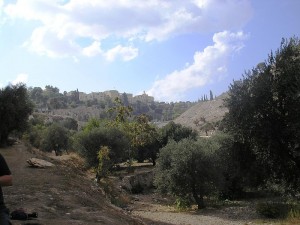Chris Date's Second Rebuttal to Jerry Shepherd

This is Chris Date's second rebuttal to Jerry Shepherd's presentation of eternal conscious torment. Here are Jerry's FIRST, SECOND, and THIRD posts. Chris's first two posts can be found HERE and HERE. We'll wrap things up next week with a short conclusion by both Chris and Jerry. ABUSING THE ANALOGY OF FAITH Jerry leaves unaddressed the vast majority of the texts I’ve cited, merely dismissing my interpretation of them because two other texts allegedly teach otherwise. This is to abuse the analogy of faith (analogia fidei), the principle according to which “no part of Scripture can be interpreted in such a way as to render it in conflict with what is clearly taught elsewhere in Scripture.”[1] I appeal to this principle, too, offering my texts as evidence that he has misunderstood his. The difference is that I have also addressed his texts, attempting to demonstrate that they are more consistent with my view. Jerry’s choice not to do the same with mine is irresponsible.
CHURCH HISTORY Jerry meaningfully interacts with only one line of evidence I presented—evidence I didn’t offer as support for my case in the first place. Attempting to falsify my introductory claim that some early

Christians believed in conditionalism, Jerry cites modern translations as evidence that Ignatius’s “we are no longer” is an idiom meaning “we are lost,” but this is an interpretive paraphrase reflecting an assumed traditional view, and not actually a translation. Jerry suggests this is comparable to Ps 130:3’s “who could stand?” The answer to the rhetorical question—tishypostēsetai (LXX), “Who will endure?”—is no one (cf. Ps 76:7; 147:17; Nah 1:6; Mal 3:2). Jerry has done himself no favors. Meanwhile, Ignatius’ Greek is more intense, used in Job 14:10 (LXX) to say “a man dying is gone [and] no longer exists” (cf. Job 4:20; 7:8, 21; Ezek 27:36). Ignatius was a conditionalist, as I originally claimed.
As for Irenaeus, Jerry should read on in the text I cited.[2] Irenaeus says God grants that souls persist after death for ages, as he grants that celestial bodies exist for ages.[3] Everything has “existence and continuance” only “as long as God wills” it. The saved receive “continuance for ever and ever,” which Irenaeus also calls “length of days for ever and ever,” but the lost “shall justly not receive from [God] length of days for ever and ever.”[4] His reference to celestial bodies demonstrates he’s talking about existence altogether, not a particular quality thereof. As further evidence, his “length of days forever and ever” comes from Ps 21:4, where the wicked are destroyed from the earth. Like Ignatius, Irenaeus was a conditionalist, even if some traditionalist scholars wish it weren’t so.
Arnobius is universally acknowledged to have been a conditionalist.[5] A hundred years before Augustine’s City of God, Arnobius’ “reputation was high, and his pupils numerous and distinguished.”[6] Scholars have known for over a hundred years that conditionalism was present in the early church, representing at minimum the teaching of the school at Ephesus.[7]
Jerry’s claim that conditionalism “was never really there to be eclipsed” is unsupportable.
THE LANGUAGE OF DESTRUCTION Whereas resurrection is physical, and takes place on earth, Jerry assumes discontinuity between God’s present and eschatological actions permits final judgment to be utterly unlike the destruction of Sodom and Gomorrah (S&G) and the antediluvian populace. Whereas their judgments were swift, literally killed people, and involved literal fire in the case of S&G, Jerry believes final judgment will be ongoing forever, will never kill, and presumably will not involve literal fire. Jerry has not substantiated that discontinuity permits this great dissimilarity, nor even that a relevant discontinuity exists in the first place.
Although Jude and Peter point to a variety of historical examples as evidence that God will surely one day judge, they offer only S&G as an “example” of the nature of that judgment (Jude 7; 2 Pet 2:6). S&G uniquely exemplify final punishment.
Much of my argument here is left unaddressed by Jerry: Matt 10:28, Rom 6:23, and John 3:16 indicate the lost will finally die; Matt 13:30, 40–42, and Mal 4:1–3, indicate they will be completely consumed, reduced to ash. Jerry needs to offer an exegesis of these passages that permits the lost instead to live forever, unconsumed.
IMMORTALITY Jerry says Adam and Eve lost their immortality, but continued to exist in Sheol after they died. This is a red herring. I began my opening case explaining that the traditional view of hell is not of disembodied souls, but resurrected living people, suffering forever. Resurrection is, by biblical definition, a return to life, the life-giving breath of God reanimating reconstituted bodies.[8] Jerry did not interact with any of my evidence here: Contrary to Jerry’s view, the risen lost cannot remain alive forever, for God revoked man’s access to the tree of life so he would return to the dust instead of living forever (Gen 3:19, 22–23), and he will restore access only to the saved (Rev 22:2). Jesus implies that only the saved will be unable to die (Luke 20:35–36). Paul says they will be made immortal—athanasia literally meaning “deathlessness”—implying that those not being made fit for the kingdom of God will remain mortal and die (1 Cor 15:50–54).[9]
ATONEMENT Jerry says he doesn’t believe Jesus ceased to be conscious in death. This is, again, a red herring. My argument is that the wages of sin is death (Rom 6:23), and as our substitute, Jesus died in our stead. If his death was in our place, then those who refuse the gift of life must themselves die—the very thing Jerry denies the risen lost will ever do. In conditionalism, Jesus’ death was truly substitutionary. In Jerry’s view, it was not.
REVELATION Jerry implies I am ignoring, discounting, or relativizing Revelation due to its apocalyptic imagery. Rather, it is Jerry who ignores and discounts the OT imagery upon which John’s vision draws: drinking God’s wrath (Job 21:20–21; Jer 25:15–33), fire, sulfur, and ever-rising smoke (Gen 19:34, 28; Isa 34:9–10) all symbolize death and destruction. Smoke rising forever in particular, like today’s mushroom cloud, communicates the totality of destruction, and is used elsewhere in Revelation to predict a city’s destruction (18:7, 10, 15, 21; 19:3).
By saying endless torment and restlessness in the imagery “informs us as to what is truly meant by the second death,” Jerry mistakenly reverses the biblical relationship between imagery and interpretation. Recall that centuries earlier, Joseph had said the cows in Pharaoh’s dream “are seven years” (Gen 41:26), and Daniel had said the tree in Nebuchadnezzar’s dream “is you, O king” (Dan 4:20–22). Jerry would have us believe the cows explain the meaning of the years, and the tree explains the meaning of the king! In reality, it is the other way around: years explain the meaning of the symbolic cows; the king explains the meaning of the symbolic tree. In Revelation, John and God likewise say the lake of fire “is the second death” (Rev 21:8; 20:14), and so the meaning symbolized by the imagery is revealed by John’s and God’s interpretation: the risen wicked will literally die a second time.
CONCLUSION The objective reader will see that Jerry’s rebuttal responds to extremely little of the evidence I presented, and dismisses the rest on the unwarranted assumption that eternal torment in John’s apocalyptic, symbolic vision predicts eternal torment in reality. Jerry then interprets the rest of the Bible’s plain and straightforward language through that tiny foggy lens. Meanwhile, I have applied sound hermeneutical principles in interpreting these texts in Revelation, and have offered a wealth of other biblical evidence in support of my reading, evidence Jerry has chosen to ignore.
Footnotes
[1] R. C. Sproul, Knowing Scripture, Rev. ed. (Downers Grove, IL: InterVarsity, 2009), 51.
[2] Against Heresies 2.34.2–3.
[3] Ibid.
[4] Ibid.; emphasis added.
[5] See, for example, John Blanchard, Whatever Happened to Hell? (Crossway, 1995), 211; Robert Peterson, Hell On Trial: The Case for Eternal Punishment (Presbyterian & Reformed, 1995), 104; and Robert Morey, Death and the Afterlife (Bethany House, 1984), 199.
[6] Handley Carr Glyn Moule, “Arnobius, an Eminent Latin Apologist for Christianity,” in A Dictionary of Christian Biography, Literature, Sects and Doctrines, eds. William Smith and Henry Wace (John Murray, 1877-1887), 167.
[7] The New Schaff-Herzog Encyclopedia of Religious Knowledge (New York; London: Funk & Wagnalls, 1908–1914), 4:176, 12:96.
[8] Chris Date, “Obfuscating Traditionalism: No Eternal Life in Hell?” Rethinking Hell [blog], http://www.rethinkinghell.com/2013/10/obfuscating-traditionalism-no-eternal-life-in-hell.
[9] Vine.





